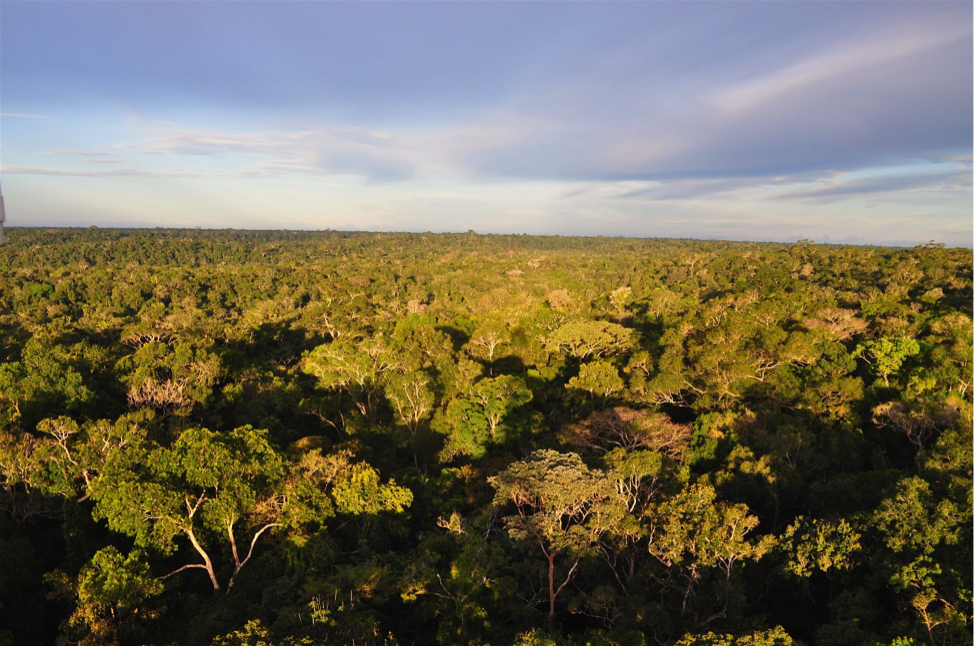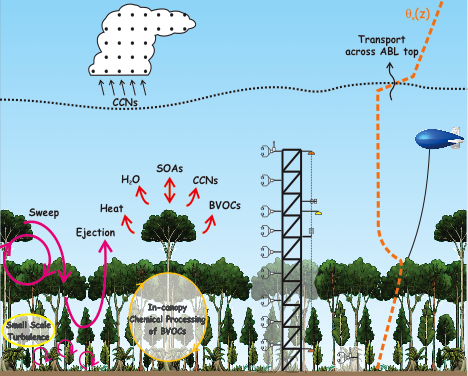
A GoAmazon study examines the aerosol-making potential within deep canopy cover
One day during the spring of 2014, Pennsylvania State University atmospheric scientist Jose D. Fuentes stood on top of a 50-meter rainforest observation tower near Manaus, Brazil.
“Suddenly,” he said, “this magnificent and colorful bird came from nowhere.” Then a troop of monkeys skittered through the tree tops in search of food. One stopped to look at him, said Fuentes, as if you to say, “What are you doing here?”
He was honoring the grand biodiversity he has studied from the North Pole to the Tropics. In this case, Fuentes was studying how tropical vegetation within the forest canopy releases chemicals that influence the formation of clouds.
Fuentes is lead author of a study published in the December 2016 Bulletin of the American Meteorological Society that links meteorology, turbulence, and air chemistry in the Amazon rainforest.
He and 19 co-authors show how the forest’s 40-meter trees and broad leaves generate hydrocarbons; how these volatile compounds are chemically processed; and how they are transported and distributed by turbulence within and above the forest’s thick canopy. For one, the team asked, when and how are these forest gases converted to the particles that influence the formation of clouds?
Their interest was the reactivity of biogenic volatile organic compounds from vegetation and how these molecules could eventually become climate-affecting aerosols. The study also looked at the intensity and frequency of turbulence within and above the forest.
Said Fuentes. “We really need to know the coupling between the emissions of gases by the trees and air turbulence.”
A Complex Exchange of Air
Researchers gathered turbulence data within the canopy. The relatively still air of mature forests is quieted by an abundance of broad leaves, but there are intermittent penetrations by “energetically strong eddies,” the study said. Data also came from the canopy-top air space (hence the high tower, strung with instruments) and from the overlying atmospheric boundary layer. (Fuentes called these combined data sets “rare” and important.)
Within tall-forest canopy, “air parcel sweeps” spear down from above, and “ejections” of air periodically escape. (See graphic.) It’s a complex exchange whose dynamics are little known. Understanding them requires understanding turbulence within the canopy.
The paper rose out of a 2014 to 2015 campaign in northwestern Brazil called Green Ocean Amazon 2014/15, funded in part by the Department of Energy’s Atmospheric System Research program and supported by American, Brazilian, and German scientists. For a full year, instruments were deployed on the ground (including an ARM Climate Research Facility mobile unit), in balloons, and in aircraft (the ARM Aerial Facility was there with with the Gulfstream-159) in order to gather coordinated data on forest-atmosphere interactions during both wet and dry seasons. The resulting data improve our understanding of tropical deep convection and the little known natural processes that drive it.
One of those natural processes is turbulence, a specialty Fuentes grew up with as a scientist. So is in-canopy chemistry, which until a decade ago he knew little about. That chemistry investigates what happens to the molecules emitted by plants, outlines their chemical reactivity, and explains how they eventually become aerosols.
“Rainforests are typically very tall—10s of meters tall—and very dense,” said Fuentes, who compared the enclosure of the canopy to a laboratory flask. It’s a chemically intense natural container of plant emissions, which are periodically shaken and mixed by localized air movement.

Isoprene, Monoterpenes, and other Forest Chemicals
Many reactive gases are given off by tropical vegetation. The most abundant by far is isoprene, which accounts for a third of all global hydrocarbons trickling into the atmosphere. (The amounts are roughly equivalent to methane emissions.) Leaves make isoprene by first assimilating carbon dioxide, which is diffused through the stomatal pores that control gas exchanges on a leaf’s surface. Chloroplasts then fix the carbon. Within the leaves, tiny sun-powered chemical factories, isoprene is biosynthesized.
Tropical forest vegetation also prominently emits monoterpenes (think of the resins on tree bark) and sesquiterpenes, the pleasant gases given off by flowers. All these plant-emitted hydrocarbons are quickly “attacked” by substances already present in the air, said Fuentes, including hydroxyl, ozone (at the highest levels during the dry season and immediately after storms), and nitrate radicals. (These can form from nitric oxide molecules that seep from soil, or are created by lightning and biomass burning.)
That resulting chemical interactions create oxidants as well as secondary organic aerosols (SOAs), which account for a big fraction of the aerosols in the Amazonian atmosphere. When sulfuric or nitric acid gets added to the in-canopy chemistry, SOAs can turn into cloud condensation nuclei. To understand the power of the rain forest to make climate-consequential gases, said Fuentes, “We have to understand the context in which that air chemistry takes place.”
That requires interdisciplinary collaboration of the kind he has championed for a decade. During GoAmazon, experts in both atmospheric chemistry and turbulence joined for the first time to investigate a common problem “in one single hut,” said Fuentes. It was there, he added, that everyone agreed, “We need to talk.”
In science there are always next steps. Fuentes and his collaborators have several papers underway. Some involve synthesizing theory with observations from the field in Amazonia. Ahead are three to five years of publication work, he said, and beyond that opportunities for other atmospheric scientists. “These data sets will have a longer legacy.”
# # #
This work was supported by the U.S. Department of Energy’s Office of Science, Office of Biological and Environmental Research as part of the Atmospheric System Research Program.
The GoAmazon field campaign was led in the United States by Harvard University and in Brazil by a consortium of Brazilian and German research groups. Scientists from Finland and Sweden also participated. The ARM Climate Research Facility is a DOE Office of Science User Facility.
Uncovering the Turbulence-Mixed Chemistry of the Amazon Rainforest
Published: 25 February 2017

